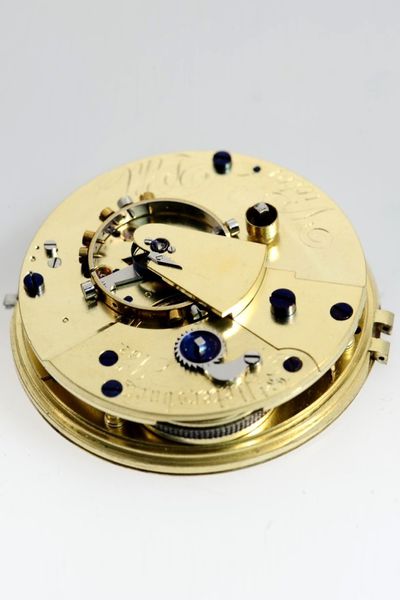Datei:Victor Pihl, St. Petersburg, Nr. 62, circa 1870 (4).jpg

Originaldatei (573 × 859 Pixel, Dateigröße: 83 KB, MIME-Typ: image/jpeg)
Victor Pihl, St. Petersburg, Werk Nr. 62, Geh. Nr. 62, 59 mm, 187 g, circa 1870

|
Alle Bildrechte liegen bei dem Auktionshaus Auktionen Dr. H. Crott. Diese Abbildung ist urheberrechtlich geschützt und steht nicht unter einer freien Lizenz. Für anderweitige Nutzungen außerhalb von Watch-Wiki ist die schriftliche Zustimmung des Urheberrechtsinhabers nötig. |
Beobachtungs-Chronometer mit 24h Gangreserveanzeige Geh.: Silber, glatt, Bodengravur: "B.T.O.N. 186/22103", Gehäusemacher-Punzzeichen "JO" (James Oliver, London). Ziffbl.: Email, radiale röm. Stunden, kleine Sekunde, gebläute Spade-Zeiger. Werk: Vollplatinenwerk, gekörnt, vergoldet, chatoniert, Schlüsselaufzug, Kette/Schnecke, Federchronometerhemmung nach Thomas Earnshaw, schwere bimetallische Chronometerunruh mit Gold- und Platinschrauben, freischwingende, gebläute, zylindrische Unruhspirale, chatonierter Diamantdeckstein auf Unruh.
Was die Signatur "B.T.O.N. 186- 22103" auf dem Rückdeckel betrifft, so kann nur vermutet werden, dass es sich um eine Observatoriums-Bezeichnung handelt, wie wir sie auch auf einem Taschenchronometer von A. Ericsson, St. Petersburg, No. 483 ,finden; dort ist – ebenfalls auf dem Rückdeckel – "B.T.O.N. 43/16780" eingraviert.
A deck chronometer with 24h power reserve indicator Case: silver, polished, engraving on the back lid: "B.T.O.N. 186/22103", case maker's punch mark "JO" (James Oliver, London). Dial: enamel, radial Roman hours, auxiliary seconds, blued spade hands. Movm.: full plate movement, frosted, gilt, chatoned, keywind, chain/fusee, spring detent escapement according to Thomas Earnshaw, heavy bimetallic chronometer balance with gold and platinum screws, freesprung blued helical balance spring, chatoned diamond endstone on balance.
As to the signature "B.T.O.N. 186- 22103" on the back cover, we can only assume that it is an observatory designation like that on a pocket chronometer no. 483 by A. Ericsson, St. Petersburg, - that piece also carries the inscription "B.T.O.N. 43/16780" on tis back.
The brothers Pihl The name Pihl stands for a number of excellent watchmakers who came, with one exception, from Pojo in the Finnish province of Nyland and worked in St. Petersburg. Bernhard Wilhelm Pihl first worked for the London company E. Dent as agent in the Russian capital but soon took over representation of Victor Kullberg as well. One of his watches (no. 20) is owned by the Eremitage. Bernhard Wilhelm Pihl died in 1860 and it seems that all his businesses were taken over by his brother Gustav Victor Pihl (born in 1846, also in Pojo). It is likely that Gustav Victor Pihl continued his brother’s numbering in his own watches. We know the numbers 63 (1870, Kullberg no. 1884), 66 (1871, Kullberg no. 2118), 67 (1871, Kullberg no. 2139) and 68 (1871, Kullberg no. 2231). Our "Pihl No. 62" fits perfectly into that line because on its dial plate it carries the number "1896", which is the number this pocket chronometer was produced with by Victor Kullberg in London! From the year dates that go with the numbers we see that it was not Bernhard Wilhelm Pihl (as Mercer states in "Chronometer Makers"), but Gustav Victor Pihl who bought and finished these timepieces (including our no. 62); he probably worked on the watches together with his other brother Anders Victor Pihl, born 1836 in Pojo. There is little doubt that the brothers Pihl did not just add an extra charge on the watches bought in England and sold them on; being chronometer makers, they surely worked on the watches to optimize their technology and general performance.
Dateiversionen
Klicke auf einen Zeitpunkt, um diese Version zu laden.
| Version vom | Vorschaubild | Maße | Benutzer | Kommentar | |
|---|---|---|---|---|---|
| aktuell | 14:48, 20. Apr. 2015 |  | 573 × 859 (83 KB) | Andriessen (Diskussion | Beiträge) | Victor Pihl, St. Petersburg, Werk Nr. 62, Geh. Nr. 62, 59 mm, 187 g, circa 1870 {{Bildrechte U|dem Auktionshaus Auktionen Dr. H. Crott}} Beobachtungs-Chronometer mit 24h Gangreserveanzeige Geh.: Silber, glatt, Bodengravur: "B.T.O.N. 186/22103", G… |
Du kannst diese Datei nicht überschreiben.
Dateiverwendung
Keine Seiten verwenden diese Datei.
- Bildgalerie Uhrwerke Pihl, Gustav Victor
- Picture gallery movements Pihl, Gustav Victor
- Galería de imagenes de mecanismos de relojes Pihl, Gustav Victor
- Afbeeldingen galerij uurwerken Pihl, Gustav Victor
- Фотогалерея Часовые механизмы Pihl, Gustav Victor
- Galleria fotografica di movimento degli orologi Pihl, Gustav Victor